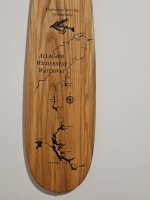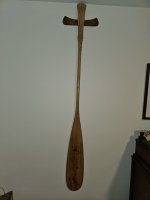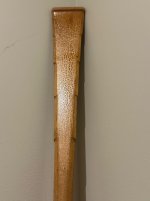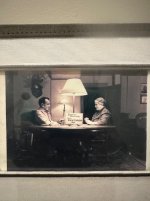Thanks for that article, Benson, which was somewhat revealing. To me, Alexandra learned her paddle making craft in a niche environment from niche sources, and I find some of her paddle ideas appealing and others not so. A scalloped secondary grip, Yes. Using a Northwood stroke, Yes (occasionally for me). Using heavy ash, No. A round shaft instead of oval, No. Heavy blade, absolutely NO!
Even as one who sometimes uses rare words and word plays in my writings, I find this explanation for her blade tip to be obscure:
"The thinnest part of her blade resides four inches inland of the tip and thereafter the blade gradually thickens toward a subtle finial bulb. This reinforcement reduces checking and produces less torque under water."
I take this to mean that she makes the blade tips fat to help prevent splitting, but have no idea what that has to do with underwater torque. This is an old gimmick when making a paddle from a solid piece of wood, but one that detracts from both balance and sliceability in my experimentation. Bruce Smith in Canada, who made my butternut ottertail but who is now ill and perhaps out of the paddle business after 50 years, also would thicken the blade tip modestly to deter splitting. However, he would perfectly balance every shaft and blade at the throat using different cut thicknesses, blade/shaft ratios, and some wood inlays.
There is no need to resort to this detrimental gimmick on a laminated wood paddle with thin edge guards or, of course, on a carbon blade, all of which can be made much lighter and better balanced than a Conover paddle.
I don't, mainly because I don't know what the term "Maine Guide paddle" means. If it means what @Tsuga8 suggests, I don't want one. While I like secondary grips very much, I will never like any heavy paddle, much less a blade heavy paddle, and I've very rarely stood up to paddle in my entire life.
My second paddle was a 57" Old Town beavertail. I don't know who made it. But it was thin, light enough and well balanced. I loved it but split the tip, the only paddle I've ever damaged in my life. It continued to be my flatwater favorite for years even while enduring some clear tape on the split. Soon thereafter, I ordered from Old Town a 54" and a 60" beavertail because of my appreciation for the 57". Both of them arrived atrociously heavy and with thick, unbalanced blades—inelegant clubs that I have never used in 45 years.
I have no idea what stroke rate Maine guides used, but suspect it depended on the guide and what kind of paddling they were doing.
If you are saying that a long, straight paddle can accelerate faster than a a short paddle, especially a short bent shaft paddle, I disagree.
If you are saying that a beavertail shape is more powerful than the Sugar Island shapes of whitewater paddlers, or the tulip shapes of flatwater and outrigger racers, or the Honey Island shapes of the early sport canoeists, or any cambered, curved or cupped blade of similar area . . . I further disagree.
All of the paddles in the following pictures are more powerful than any of my three beavertails or ottertail.
Here is a 1980s Mitchell curved blade whitewater paddle (used by Jon Lugbill to win several whitewater slalom world championships), and two curved blade 1970s-80s Lutra sport canoeing (later freestyle) paddies made by the Blackburn brothers and by Mitchell:
View attachment 148611
In the next picture, I consider the three straight and symmetrical bladed paddles to the right of the Bruce Smith ottertail to be more powerful than it or any beavertail. They are, from left to right, a Gillespie Free (designed by me), a Patrick Moore Cue (from the late 80s) and a Z Whitewater. And they are all better shallow water paddles than any animal tail paddle.
View attachment 148612
-
Happy National Eggnog Day! 🎄🥛😵
You are using an out of date browser. It may not display this or other websites correctly.
You should upgrade or use an alternative browser.
You should upgrade or use an alternative browser.
The Maine Guide Paddle
- Thread starter lowangle al
- Start date
Glenn, you obviously don't need a long, big bladed paddle for your use, but if you did there are light (for their size) well balanced ones out there.
As far as that 57" OT paddle that you liked but were disappointed with the replacements. Some paddles just have the right feel, I'll never spend money on a paddle sight unseen, unless I can get a weight on it.
Sugar Island and similar shaped paddles do have a lot of power, due to their width. But they don't have the surface area of a 30" long 8.5" beavertail, and can't physically move as much water, especially with a long shaft.
In the situations where I grab my Maine Guide paddle, stroke rate isn't any more of a consideration than it would be for doing white water maneuvers. I use it for twisty streams or when I need more leverage in wind. I haven't used it in much WW but the little I did I was impressed with how easy it was to catch an eddy with it while standing. Also, like I mentioned earlier you can get a more bouyant brace then you can with a shorter paddle with a smaller blade.
Getting to your assertion that you can accelerate better with a short bent shaft, my gut feeling is that you don't have enough leverage to come close.
As far as that 57" OT paddle that you liked but were disappointed with the replacements. Some paddles just have the right feel, I'll never spend money on a paddle sight unseen, unless I can get a weight on it.
Sugar Island and similar shaped paddles do have a lot of power, due to their width. But they don't have the surface area of a 30" long 8.5" beavertail, and can't physically move as much water, especially with a long shaft.
In the situations where I grab my Maine Guide paddle, stroke rate isn't any more of a consideration than it would be for doing white water maneuvers. I use it for twisty streams or when I need more leverage in wind. I haven't used it in much WW but the little I did I was impressed with how easy it was to catch an eddy with it while standing. Also, like I mentioned earlier you can get a more bouyant brace then you can with a shorter paddle with a smaller blade.
Getting to your assertion that you can accelerate better with a short bent shaft, my gut feeling is that you don't have enough leverage to come close.
That's interesting, Al. I won what was supposed to be a Penobscot paddle from S&T in the NFCT auction. The Penobscot is the same blade as the 1897 but with a pear grip instead of the blockier grip (as you know but others may not), and I asked them for an 1897 instead of a Penobscot, which they nicely obliged. When I first got it and gripped the grip, I thought I'd made a big mistake on the grip. But actually, like you, I've come to really appreciate it for both palm rolled and northwoods strokes.Nice paddle Alex. I have three of the same ones. An ash 72" beavertail with elongated grip from The Bark Canoe Store, a 60" S&W 1897 in Cherry and two of the Old Towns like the one on the right. I wasn't a fan of the grip on the 1897 until I started using it. It looked big and clunky, but it was actually more comfortable than the small pear shaped grips that I thought I preferred. I also never thought of it as being "long", but I guess it is.
I thought it was interesting that Caleb Davis said that the elongated grip is for doing one handed prys, I don't think he mentioned anything about shortening the paddle length. Also, as far as wider blades being more tiring due to resisting the twisting torque, I've never noticed that. It was more about pulling more water per stroke. All paddles are different though and my big wide bladed paddle also has a very wide shaft that may compensate for it.
I didn't mention Tremolo or Bruce Smith paddles' secondary grips because the makers both say they're for single-handed pry moves, which I think disqualifies them from being Maine Guide paddles. But, those secondary grips do actually work well for the Northwoods stroke, especially the Tremolo. That said, both makers suggest shorter paddle lengths, which makes it a bit harder to use that secondary grip for the Northwoods stroke, another strike against calling them Maine Guide paddles in my opinion. (But they're great paddles in their own right! )
Not offering any opinion here, just evidence, neither for nor against. My wife’s great grandfather was the owner operator of Camp Caribou on the western shore of North Bay in Moosehead Lake back in the teens, 20s 30s and 40s - near a place on the map called Ogontz, though for a ‘place’, there ain’t much there. Here are two of his paddles that have wound up in my care. They are both a century old, so I have no idea how well they may or may not work. danged if I’m gonna be the guy that breaks them trying. The bigger one is a full 6 feet tall and has an 8 inch blade that is 30 inches long. The ‘short’ one is 5’7” and has a 7 1/2 inch blade, about 28 inches long. Note the different grips on the shorter one, that are absent on the taller one. Neither are quite as light as a carbon fiber Werner bandit, but they don’t weigh much. No idea what wood they might be made of.
Attachments
Very cool paddles with a great backstory. Look and sound like they fit the bill to me (not that I'm any sort of expert). I'm gonna guess spruce on the wood but others here may know better.
Nice paddles. Too bad he was probably gone before you got to meet him. I'm sure he had some good stories to tell.Not offering any opinion here, just evidence, neither for nor against. My wife’s great grandfather was the owner operator of Camp Caribou on the western shore of North Bay in Moosehead Lake back in the teens, 20s 30s and 40s - near a place on the map called Ogontz, though for a ‘place’, there ain’t much there. Here are two of his paddles that have wound up in my care. They are both a century old, so I have no idea how well they may or may not work. danged if I’m gonna be the guy that breaks them trying. The bigger one is a full 6 feet tall and has an 8 inch blade that is 30 inches long. The ‘short’ one is 5’7” and has a 7 1/2 inch blade, about 28 inches long. Note the different grips on the shorter one, that are absent on the taller one. Neither are quite as light as a carbon fiber Werner bandit, but they don’t weigh much. No idea what wood they might be made of.
Going by my definition and Shaw and Tenneys, I would say only the longer one with the oversized blade is a Maine Guide Paddle. It doesn't matter what you call it, but it is an oversized beaver tail.
I can understand why you're afraid to use them, but I think as long as there is no rot they would be OK as long as you took it easy.
I'm curious, @lowangle al , would you consider the Bennett/S&T Northwoods to not be a Maine Guide paddle because of the narrower blade? What about my OT paddle that's only 59in with a 6.5in wide blade? I suppose I'm lumping; perhaps you'd split them out and call them something else?
Going by what S&T offers on their website, they list a Northwoods Paddle and a Maine Guide as separate designs. It doesn't matter much what I think, I wonder what Alexandra would call them? I'm sure it's a grey area with varying opinions.
I've enjoyed following this thread and have one thought to offer. Words and language are powerful. "Maine" and "Guide" assume some cultural appropriation that does not acknowledge the fact that current paddle designs are adaptations and refinements of paddles developed over thousands of years by indigenous people.
In the case of the Maine Guide Paddle my hunch is that the oversize blade is an adaptation by actual Maine Guides. I think the standard beaver tail and probably the Northwoods grip go way back historically. It would be interesting to know if there are any examples of it being used by Natives before the arrival of the white man.
I think the standard beaver tail and probably the Northwoods grip go way back historically. It would be interesting to know if there are any examples of it being used by Natives before the arrival of the white man.
Murat's Paddle Making blog is a great resource if you want to explore very old paddles at the first link below. Paddles, canoes, and other wooden objects don't survive very well in most North American soils so the archaeological record is a bit thin. We know much more about the stone tools used to make these things. The second link documents my trip down a very old paddle rabbit hole a few years ago.
Benson
Paddle Making (and other canoe stuff)
Functional paddle art and other canoe related ramblings
Paddles and Bark Canoe Models at the Peabody Museum in Cambridge, Massachusetts
I retired at the end of December and celebrated by visiting the Peabody Museum in Cambridge, Massachusetts last week to see a very popular Wabanaki paddle. In full disclosure, this is my second trip to see this paddle. My first trip was to the Peabody Essex Museum (https://www.pem.org/) but...
Last edited:
Thanks for posting those links Benson. I love Murat's' site and can spend a lot of time there.
It isn't conclusive but I only saw one example of a paddle with a wide blade, as compared to the others from that time period. It was listed as a Wabanaki, probably Penobscot 74" with a wide blade. There was a key at the bottom of the photo and if it was in inches that blade was less than 8" wide.
It isn't conclusive but I only saw one example of a paddle with a wide blade, as compared to the others from that time period. It was listed as a Wabanaki, probably Penobscot 74" with a wide blade. There was a key at the bottom of the photo and if it was in inches that blade was less than 8" wide.
It could, but shouldn't, go without saying that all this technology stands on a foundation of thousands of years of indigenous development and innovation. Thanks for calling it out explicitly, RickR.I've enjoyed following this thread and have one thought to offer. Words and language are powerful. "Maine" and "Guide" assume some cultural appropriation that does not acknowledge the fact that current paddle designs are adaptations and refinements of paddles developed over thousands of years by indigenous people.
Thanks, Benson for sharing those great resources.
I may have missed this in the threads but there is a video somewhere online when Sam Martenelli from Shaw and Tenney mentioned that he constantly reminds himself to leave more wood (thickness) near the bottom of the blade on the North Woods paddle design as inherited from Alexandra. It is very noticeable on my S&T North Woods particularly when compared with other paddles I own. You don't need to use a micrometer to gauge the thickness and I am wondering if that is why some paddlers find the paddle not to their liking? Anyhow, this has been a terrific discussion folks!
Dan
Dan
D J, how do you like using the Northwoods paddle, and what wood is it?
I like your commemorative paddle above. It's a really nice gift but I wouldn't let that stop me from giving it a try on the water. I take a long paddle as my second paddle and mostly only use it to stand or if it's windy and I need the extra leverage. I think there would be little chance of damaging it from normal use. How does the blade compare to the Northwoods as far as size goes and is it 8.5" wide as advertised.
I like your commemorative paddle above. It's a really nice gift but I wouldn't let that stop me from giving it a try on the water. I take a long paddle as my second paddle and mostly only use it to stand or if it's windy and I need the extra leverage. I think there would be little chance of damaging it from normal use. How does the blade compare to the Northwoods as far as size goes and is it 8.5" wide as advertised.
Hi, the commemorative paddle gifted to me is a Shaw and Tenney Northwoods. After Sam and crew took over manufacturing the design from Alexandra Conover Bennett, they number each Northwoods paddle they make. This is #181 and 66" long. I have a couple of 1950's S&T beavertail paddles I am refurbishing. One is a 72" paddle I plan on using as my stand up paddle. Anyhow, I took a few measurements...
The S&T Northwoods is ash, 66" long with scalloped grip, is 6 5/8" at widest point on blade, and is 0.335" thick at blade tip. It is not a light paddle but well balanced.
The old S&T 6 footer is ash, traditional S&T grip, is 6 3/4" at widest point, and is 0.295" thickness at blade tip. I don't have a way to weigh them but this older paddle is much heavier in my estimation.
My son told me the same thing, "use the paddle" but just can't bring myself to mess up that work of art sentimental old fool that I am.
sentimental old fool that I am.
The S&T Northwoods is ash, 66" long with scalloped grip, is 6 5/8" at widest point on blade, and is 0.335" thick at blade tip. It is not a light paddle but well balanced.
The old S&T 6 footer is ash, traditional S&T grip, is 6 3/4" at widest point, and is 0.295" thickness at blade tip. I don't have a way to weigh them but this older paddle is much heavier in my estimation.
My son told me the same thing, "use the paddle" but just can't bring myself to mess up that work of art
I didn't realize they were the same paddle. The curiosity of how it paddled would be killing me. If you tried it and didn't like it, you could hang it back on the wall with no regrets. If you loved it, you might reconsider. I would think that a S&W commemorative paddle is made to the same standards as their others.
As far as blade shape, you answered my question as to whether the Northwoods has the same shape as their other beaver tails. I have three S&Ws, two from the late 90's and one from a few years ago. All are cherry. They have an identical shape, but vary in thickness. The two older ones are lightly constructed with a very thin edged blade, the other one is very heavy. I spoke with Sam about it and he said they don't have a standard for thickness. He said that is up to the carver and how he feels about the strength of the wood. I shaved over 4 ounces off of it and it is still too heavy for me to use and unfortunately I got it for my wife. Now it's a paddle that no-one uses, so either I shave it down some more or keep it for use as a WW paddle for the wife.
As far as blade shape, you answered my question as to whether the Northwoods has the same shape as their other beaver tails. I have three S&Ws, two from the late 90's and one from a few years ago. All are cherry. They have an identical shape, but vary in thickness. The two older ones are lightly constructed with a very thin edged blade, the other one is very heavy. I spoke with Sam about it and he said they don't have a standard for thickness. He said that is up to the carver and how he feels about the strength of the wood. I shaved over 4 ounces off of it and it is still too heavy for me to use and unfortunately I got it for my wife. Now it's a paddle that no-one uses, so either I shave it down some more or keep it for use as a WW paddle for the wife.
Have you tried a Racine from S&T? I have a 63" in cherry and it it is a great lake paddle. I think my other beavertails from S&T including the 6 footer are what they now label their Penobscot model based upon the dimensions. I' do my best to get the Northwoods commemorative off the wall, on the water and give it a try before too much longer.I didn't realize they were the same paddle. The curiosity of how it paddled would be killing me. If you tried it and didn't like it, you could hang it back on the wall with no regrets. If you loved it, you might reconsider. I would think that a S&W commemorative paddle is made to the same standards as their others.
As far as blade shape, you answered my question as to whether the Northwoods has the same shape as their other beaver tails. I have three S&Ws, two from the late 90's and one from a few years ago. All are cherry. They have an identical shape, but vary in thickness. The two older ones are lightly constructed with a very thin edged blade, the other one is very heavy. I spoke with Sam about it and he said they don't have a standard for thickness. He said that is up to the carver and how he feels about the strength of the wood. I shaved over 4 ounces off of it and it is still too heavy for me to use and unfortunately I got it for my wife. Now it's a paddle that no-one uses, so either I shave it down some more or keep it for use as a WW paddle for the wife.
I have not, but if yours is light, fine edged, and flexy like my two older S&Ws then I bet it's a great paddle. I have a Sawyer otter tail with a similar blade that I really like on big lakes.
Good luck with the Northwoods, I don't see much downside in trying it out.
Good luck with the Northwoods, I don't see much downside in trying it out.
Similar threads
- Replies
- 11
- Views
- 1K






